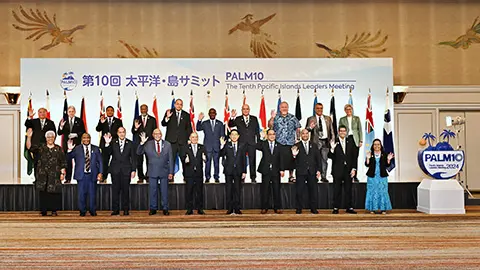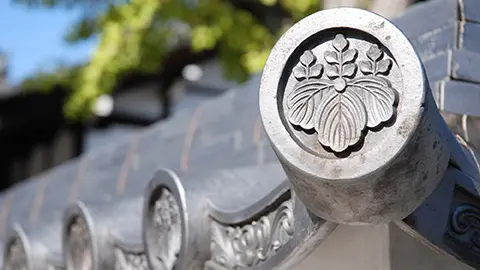VOL.194 JULY 2024
JAPANESE SMALL AND MEDIUM ENTERPRISES LEADING THE WORLD
[Discovering Japan Through the Eyes of Japanese Influencers] Japanese Wedding Attire — Gorgeous Beauty and Deep, Rich Traditions

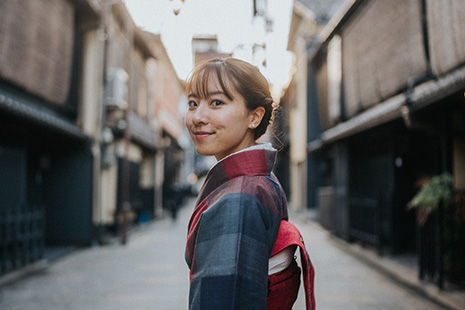
Kaaisan is a Kyoto-based creator who promotes Japanese culture in English day-by-day.
In this month’s issue, Kaaisan talks about Japan’s wedding attire.
Did you know that one of the accessories of the traditional Japanese bridal attire is a smallish short sword? This is a leftover from a society where samurai warriors were prominent. As you can see, even an aspect of wedding costume can reveal traditions, aesthetics, and beliefs that have been passed down from generation to generation in Japan. Welcome to the gorgeous, rich, and complex world of Japanese wedding attire.
Bride’s attire
Similar to the image of Western wedding dresses, in Japan white is considered a sacred and pure color, and an outfit called shiromuku (literally “pure white”), which consists of a white kimono, white obi (sash), and white accessories is the most classic bridal attire. Recently, it has become fashionable to wear a colorful kimono under the white kimono or, conversely, to choose a vibrantly colored and patterned uchikake, a gown-like garment with a long hem that is worn as the outermost layer of the kimono.
Just as a veil is worn over a wedding dress, the bride in Japan wears a white hat (wataboshi) or a kind of headdress (tsunokakushi) to cover her head. In fact, the hairstyle hidden under such headgears is also unique. The bunkin takashimada* hairstyle, which was popular among women in the late 19th century, has become a standard for brides. But today, it is common to wear a wig with this hairstyle.

A smallish short sword for protection called a “kaiken” and an accessory pouch are tucked into the folds of bride’s her robe. Both are believed to have been carried by women of the samurai class around the 17th century, and they were incorporated into the traditional bridal attire as accessories beginning in the 19th century. The accessory pouch was likely used to carry a handkerchief, medicine, cosmetics, etc.
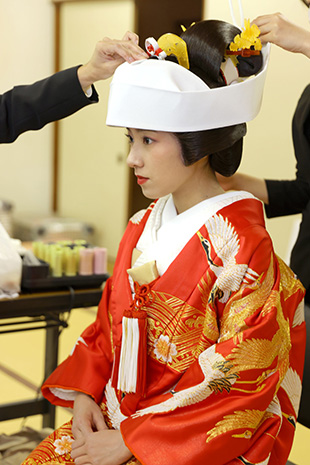
Photo: Kaaisan
The patterns on wedding kimonos are not purely decorative. They are chosen for their auspicious nature, which has been passed down as part of ancient beliefs and traditions. Such patterns include cranes, a symbol of longevity and vitality, and seigaiha (literally “blue ocean waves”),** a symbol of permanent peace.

Photo: Kaaisan
Groom’s attire
The traditional wedding attire for the groom is called kuromonpuku (or “black haori and hakama with five crests”). This formal outfit consists of a black kimono, hakama pants with striped pattern, and a black haori (overcoat). The overcoat has a kamon (family crest) embroidered on five places. This crest is a symbol of the family lineage and social status inherited from his ancestors.
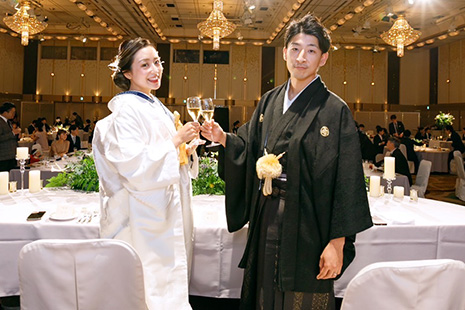
Photo: Kaaisan
Attendees’ attire
In modern Japan, Western-style attire has become the norm for attendees, with many men wearing suits and a growing number of women wearing classical and formal day dresses, although white is avoided. However, female relatives of the couple are more likely to wear kimonos. The mothers of the groom and the bride wear kuro-tomesode, a type of black kimono with shorter sleeves and elaborate designs on the lower half only. Married women wear iro-tomesode, a colored kimono with shorter sleeves and no designs on the upper half. Unmarried women wear furisode, a colored kimono with elaborate designs on both the top and bottom, and long sleeves that reach down to their feet.
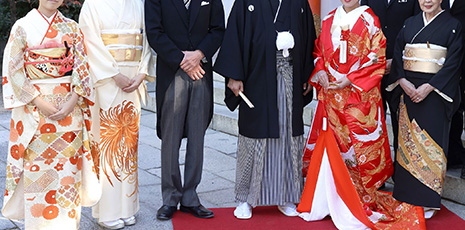
The woman on the far left is wearing a furisode (long-sleeved kimono), usually reserved for young, unmarried women. The second woman from the left is wearing iro-tomesode (colored kimono with shorter sleeves), typically worn by married women. The third person from the left is the father of the groom or the bride. He is dressed in a Western-style morning coat. The man next to him is the groom. He is wearing a traditional wedding outfit called kuromonpuku. The second person from the right is the bride, who is dressed in a gorgeous patterned uchikake. The person on the far right is the mother of the groom or the bride. She is wearing a kuro-tomesode (black formal kimono with shorter sleeves).
Photo: Kaaisan
Originally, many Japanese weddings were held at home, but since the 20th century it has become common to hold weddings outside the home, in wedding halls or shrines. Also, due to the new custom of taking commemorative wedding photos on occasions separate from the actual wedding ceremony, there are more opportunities to see people in various Western and Japanese wedding attire on the streets of Japan today. If you are traveling in Japan and come across such couples, be sure to quietly congratulate them with the Japanese phrase “Omedeto” (unless they are in the middle of their severe wedding ceremony).
Kaaisan
Creator of English-language short film introductions to Japan. She manages an online community for like-minded people interested in Japanese culture and worldview to meet and learn together. She also plans and organizes various events on an irregular basis.![]()
* One of the traditional Japanese hairstyles. There are different theories about its origin. In modern Japan, it is a typical hairstyle for brides wearing traditional Japanese attire (see photo).
** A traditional fan-shaped geometric pattern representing ocean waves, which has been used in Japan since ancient times. The endlessly repeating wave pattern is an expression of hope for a peaceful life and long-lasting happiness.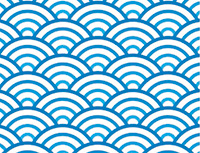 (An example of a Seigaiha pattern)
(An example of a Seigaiha pattern)
By Kaaisan
Photo: Kaaisan; PIXTA
